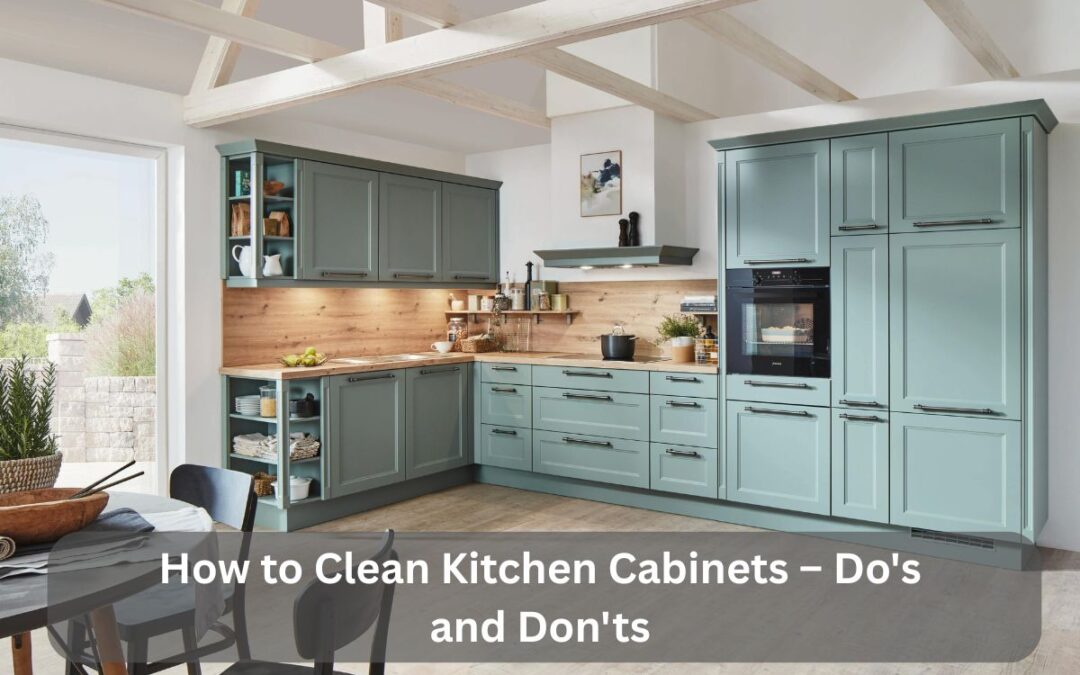Kitchen cabinets collect grease, fingerprints, dust, and food particles over time, making them one of the most maintenance-intensive parts of a kitchen. Cleaning cabinets effectively requires the right methods and materials—choosing the wrong ones can damage finishes or leave residue.
Key Takeaways
- Regular cabinet cleaning prevents long-term buildup of grease, grime, and stains.
- Do use mild cleaners, soft cloths, and consistent maintenance to protect cabinet finishes.
- Don’t use harsh chemicals, abrasive scrubbers, or excessive water that may damage wood or laminate.
- Different cabinet materials—wood, laminate, painted, or metal—require tailored cleaning approaches.
- Preventive habits, such as sealing and quick wipe-downs, extend the life of cabinets.
Why Proper Cabinet Cleaning Matters
Kitchen cabinets serve both functional and aesthetic roles, storing food and cookware while defining the overall look of the space. Improper cleaning not only affects appearance but can also:
- Weaken finishes and coatings.
- Cause discoloration or warping of wood.
- Leave streaks, smudges, or sticky residues.
- Encourage mold and odor buildup inside cabinets.
Fast Fact
According to a 2024 Home Care Survey, 58% of homeowners said kitchen cabinets were the most difficult area to keep consistently clean.
Do’s: Best Practices for Cleaning Kitchen Cabinets
1. Do Clean Regularly
Consistent cleaning prevents stubborn buildup.
- Wipe down exterior cabinet doors weekly.
- Deep clean cabinet interiors every 2–3 months.
- Address spills or grease splatters immediately.
Example
A weekly wipe-down with a damp microfiber cloth around stove-side cabinets helps avoid hardened grease layers that require scrubbing.
2. Do Use Mild Cleaners
Harsh chemicals can strip finishes or discolor surfaces. Instead, choose gentle options.
- Mild Dish Soap: Mix a few drops with warm water for everyday cleaning.
- Vinegar Solution: Equal parts vinegar and water can cut grease naturally.
- Baking Soda Paste: Effective on sticky or stubborn spots without scratching.
Important
Always test a cleaning solution on an inconspicuous area first.
3. Do Use Soft Materials
The right tools prevent scratches.
- Use microfiber cloths for wiping.
- Opt for soft-bristled brushes to clean crevices and handles.
- Dry with lint-free cloths to avoid streaks.
4. Do Tailor Cleaning to Cabinet Material
Different cabinet finishes respond differently to cleaning methods.
- Wood Cabinets: Use wood-safe cleaners and dry immediately to prevent warping.
- Laminate or Thermofoil: Mild soap and water are usually sufficient. Avoid excess water seeping into edges.
- Painted Cabinets: Gentle dish soap solution works best. Harsh chemicals may strip paint.
- Metal Cabinets: Stainless steel cleaners or diluted vinegar can restore shine without streaks.
5. Do Protect Cabinets After Cleaning
Preventive care extends longevity.
- Apply furniture polish or mineral oil to wood cabinets for added shine.
- Use shelf liners to reduce food spills inside.
- Install range hoods or splatter guards to reduce grease on exterior surfaces.
Don’ts: Common Mistakes to Avoid
1. Don’t Use Harsh Chemicals
Bleach, ammonia, or strong solvent-based cleaners can damage finishes, lighten wood, or discolor laminate.
Example
Using bleach on a painted cabinet may strip the color unevenly, requiring repainting.
2. Don’t Over-Saturate with Water
Too much water can warp wood, swell particleboard, or seep into seams.
- Avoid soaking cloths or spraying directly onto cabinets.
- Always wring cloths before wiping.
3. Don’t Use Abrasive Tools
Steel wool, scouring pads, or rough sponges scratch surfaces. Over time, these scratches trap dirt and grease.
Important
Stick to soft cloths and brushes to preserve finishes.
4. Don’t Ignore Handles and Hardware
Cabinet knobs, pulls, and hinges often harbor grease and bacteria.
- Clean hardware separately using mild soap and water.
- Avoid abrasive cleaners that may strip finishes on metal hardware.
5. Don’t Forget to Ventilate After Cleaning
Trapped moisture can cause odors or mold. After cleaning interiors:
- Leave cabinet doors open until completely dry.
- Use fans or natural airflow to speed up drying.
Step-by-Step Cleaning Routine
- Empty Cabinets: Remove all items to access corners and surfaces.
- Dust and Vacuum: Clear crumbs, cobwebs, or loose dirt.
- Clean with Mild Solution: Wipe interiors and exteriors using a soft cloth and gentle cleaner.
- Address Stubborn Spots: Apply baking soda paste or vinegar to grease-heavy areas.
- Dry Thoroughly: Ensure all surfaces are moisture-free.
- Organize and Restock: Replace items neatly, discarding expired products.
Preventive Care Tips
- Use Shelf Liners: Protect against spills and crumbs.
- Install Exhaust Fans: Reduce airborne grease settling on cabinet surfaces.
- Handle with Clean Hands: Prevent fingerprints and oils from building up.
- Seasonal Maintenance: Perform deep cleaning every 3–4 months to maintain hygiene.
Fast Fact
Cabinet interiors near stoves or sinks tend to accumulate twice as much grime as those further away, according to a 2023 kitchen maintenance study.
Example: Applying the Do’s and Don’ts in Practice
A homeowner with oak wood cabinets noticed sticky patches near the stove. Instead of using an abrasive scrubber, they applied a vinegar and water solution with a microfiber cloth, then dried the area immediately. By following the do’s (gentle cleaner, soft cloth, immediate drying) and avoiding the don’ts (abrasives, excess water), the cabinets retained their finish while looking clean and refreshed.
FAQs
How often should I clean my kitchen cabinets?
Light cleaning should be done weekly, while interiors and deep cleaning are recommended every 2–3 months.
Can vinegar damage wooden cabinets?
Diluted vinegar is safe for most finishes, but prolonged or repeated use without drying can dull wood. Always test in a small area first.
What’s the best way to remove grease from cabinets?
A mixture of dish soap and warm water is effective. For heavier buildup, baking soda paste can help break down grease without scratching.
Is it safe to use disinfectant wipes on cabinets?
Most disinfectant wipes are safe for laminate or painted cabinets but may dry out wood finishes. For wood, use wipes labeled safe for wood surfaces.
Do I need to polish cabinets after every cleaning?
Polishing is not required after every cleaning but can be done occasionally to maintain shine and add a protective layer, especially for wooden cabinets.
The Bottom Line
Cleaning kitchen cabinets correctly requires balancing effectiveness with care. The do’s—regular cleaning, mild solutions, soft cloths, and preventive maintenance—help preserve both appearance and durability. The don’ts—harsh chemicals, abrasives, excess water, and neglect of hardware—can cause lasting damage.
By following these guidelines, homeowners can ensure that their cabinets remain clean, hygienic, and visually appealing, while avoiding costly repairs or replacements caused by improper cleaning practices.

As the chief content writer, Hassan Al Sarker works as a professional kitchen-based content creator at Kitchen Liker.
In addition to reviewing the content published on Kitchen Liker, he ensures that it is accurate, relevant, and helpful. As a result, all the reviews and information published at Kitchen Liker are neutral and userfriendly.
Hassan Al Sarker has a bachelor’s degree in Hotel and Tourism Management From the Newyork University. Before joining Kitchen Liker, he was a contributor at Kitchen Club, United States.

